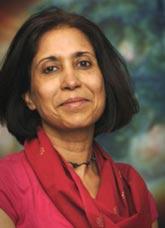You are here
Madhulia Guhathakurta
Madhulia Guhathakurta
Associate Research Professor; Physicist
Institution:Catholic University of America; NASA Goddard Space Flight Center
Education:
BS - Physics, Delhi University
MS - Physics and Astrophysics, Delhi University
PhD - Physics, University of Denver
Teaches; studies the solar corona using data from satellites
As a NASA astrophysicist, Dr. Madhulika Guhathakurta (also known as Lika) has had the opportunity to work as a scientist, mission designer, instrument builder, directing and managing science programs and teacher and spokesperson for NASA's mission and vision in the Heliophysics Division. Occasionally, she performs all of these roles in a single day.
Before joining NASA Headquarters in December of 1998, her career has focused on studying the importance of the scientific exploration of space in particular understanding the Sun as a star and its influence on the planet Earth, with research focus on understanding the magneto hydrodynamics of the Sun’s outermost layer, the solar corona. She has been a Co-Investigator on five Spartan 201 missions on aboard space shuttles to study the solar corona in white-light and UV radiation and has authored over 70 publications.
Dr. Guhathakurta is the Lead Program Scientist for NASA's initiative called "Living With a Star" (LWS) which focuses on understanding and ultimately predicting solar variability and its diverse effects on Earth, human technology and astronauts in space. The systems science behind this new kind of weather outside of Earth’s terrestrial atmosphere is known as "Space Weather”. She is also the Program Scientist for “Solar TErrestrial RElations Observatory” (STEREO), scheduled to launch in July 2006. STEREO is a two-year mission which will employ two nearly identical space-based observatories - one ahead of Earth in its orbit, the other trailing behind - to provide the first-ever stereoscopic measurements to study the Sun and the nature of its coronal mass ejections, or CMEs and their impact on space-weather.
She is presently leading two science definition teams for future missions in the LWS Program, “Solar Probe” and “Solar Sentinels” and involved in a mission in formulation “Radiation Belt Storm Probes (RBSP)”. Solar Probe will be a historic mission, flying into one of the last unexplored regions of the solar system, the Sun’s atmosphere or corona, for the first time. Approaching as close as 3 RS above the Sun’s surface, Solar Probe will employ a combination of in-situ measurements and imaging to achieve the mission’s primary scientific goal: to understand how the Sun’s corona is heated and how the solar wind is accelerated. Solar Sentinels, an important mission for NASA’s Vision for exploration will help in the understanding and prediction of Solar Energetic Particle (SEPs) and solar eruptive events, and their effects on the interplanetary environments, planets, and other solar system bodies. RBSP’s science objectives are to provide understanding of how populations of relativistic electrons and ions in space are formed or changed in response to solar variations. In addition to leading science missions for the LWS program, Dr Guhathakurta also manages a theory, modeling and data analysis program to integrate scientific output, data, and models to generate a comprehensive, systems understanding of Sun-Heliosphere-Planets coupling.
Dr. Guhathakurta is leading an effort in an international initiative known as the “International Living With a Star” (ILWS) consisting of all the space agencies of the world to contribute towards the scientific goal for Space Weather understanding.
A native of India, Dr. Guhathakurta received her Masters in Astrophysics from University of Delhi and Ph.D. in Physics from University of Denver and University of Colorado at Boulder.
Lack of funding
Challenges:
Facing budget constraints; writing proposals for funding
Job Sector: Highest Degree:
